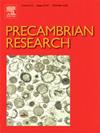Revisiting the formation ages of Tangjiazhuang Group: Insights from new U-Pb zircon ages in TTG gneisses of the Jiaobei terrane, North China Craton
IF 3.2
2区 地球科学
Q2 GEOSCIENCES, MULTIDISCIPLINARY
引用次数: 0
Abstract
The Jiaobei terrane is a typical and representative early Precambrian terrane of the North China Craton (NCC) characterized by extensively metamorphosed supracrustal rocks. These supracrustal units are of great importance for deciphering the NCC’s tectonic evolution, mineralization processes, and environmental responses during the early Earth. However, the distribution of Archean supracrustal rocks in the Jiaobei terrane is not as extensive as in other parts of the NCC. Despite the most commonly used classification of the Archean supracrustal rocks in the Jiaobei terrane into the Mesoarchean Tangjiazhuang Group and the Neoarchean Jiaodong Group, the precise formation age of the Tangjiazhuang Group has remained elusive. Addressing this gap, this study introduces new zircon U–Pb geochronological insights from TTG (Tonalite-Trondhjemite-Granodiorite) gneisses that intruded the Tangjiazhuang Group. The analyzed zircons predominantly exhibit magmatic cores with metamorphic overgrowth rims, indicative of complex geological processes. Our findings reveal two distinct age groups at 2794 ± 27 Ma and 1914 ± 36 Ma, corresponding to the intrusion of TTG gneisses during the late Mesoarchean and their subsequent metamorphism in the Paleoproterozoic, respectively. They were later intruded by the Paleoproterozoic granitic gneiss at 2194 ± 16 Ma. Combined with field observation and previous studies, the new age data definitively suggest that the Tangjiazhuang Group was formed by at least the late Mesoarchean, thereby offering crucial refinements to the temporal framework for the early crustal formation and evolution of the NCC. The lack of continent-derived components (pelitic rocks) in this lithological unit implies submerged environment for the Mesoarchean Jiaobei terrane of the eastern NCC.
重新审视唐家庄群的形成时代:华北克拉通焦北地块TTG片麻岩U-Pb锆石新年龄的启示
焦北地体是华北克拉通早前寒武纪的典型地体,以广泛变质的表壳岩为特征。这些上地壳单元对于破译北陆块早期的构造演化、成矿过程和环境响应具有重要意义。然而,交北地体中太古宙上壳岩的分布并不像北陆盆地其他地区那样广泛。尽管目前最常用的将焦北地体太古代表壳岩划分为中太古代唐家庄群和新太古代胶东群,但唐家庄群的确切形成年代仍不明确。为了弥补这一空白,本研究从唐家庄群的TTG (tonalite - trondhjemite -花岗闪长岩)片麻岩中引入了新的锆石U-Pb年代学见解。分析的锆石主要表现为岩浆岩心和变质过度生长的边缘,表明其地质过程复杂。研究结果显示,在2794±27 Ma和1914±36 Ma两个不同的时代,分别对应于中太古代晚期TTG片麻岩的侵入和随后的古元古代变质作用。后来在2194±16 Ma被古元古代花岗质片麻岩侵入。结合野外观测和前人研究,新时代资料明确表明唐家庄群至少形成于中太古代晚期,从而为北陆早期地壳形成和演化的时间框架提供了重要的完善。该岩性单元缺少陆源成分(泥质岩),说明北陆块东部中太古代胶北地体处于水下环境。
本文章由计算机程序翻译,如有差异,请以英文原文为准。
求助全文
约1分钟内获得全文
求助全文
来源期刊

Precambrian Research
地学-地球科学综合
CiteScore
7.20
自引率
28.90%
发文量
325
审稿时长
12 months
期刊介绍:
Precambrian Research publishes studies on all aspects of the early stages of the composition, structure and evolution of the Earth and its planetary neighbours. With a focus on process-oriented and comparative studies, it covers, but is not restricted to, subjects such as:
(1) Chemical, biological, biochemical and cosmochemical evolution; the origin of life; the evolution of the oceans and atmosphere; the early fossil record; palaeobiology;
(2) Geochronology and isotope and elemental geochemistry;
(3) Precambrian mineral deposits;
(4) Geophysical aspects of the early Earth and Precambrian terrains;
(5) Nature, formation and evolution of the Precambrian lithosphere and mantle including magmatic, depositional, metamorphic and tectonic processes.
In addition, the editors particularly welcome integrated process-oriented studies that involve a combination of the above fields and comparative studies that demonstrate the effect of Precambrian evolution on Phanerozoic earth system processes.
Regional and localised studies of Precambrian phenomena are considered appropriate only when the detail and quality allow illustration of a wider process, or when significant gaps in basic knowledge of a particular area can be filled.
 求助内容:
求助内容: 应助结果提醒方式:
应助结果提醒方式:


